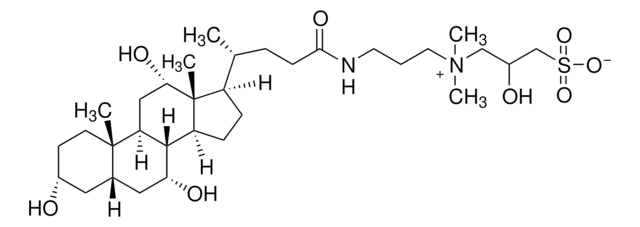O3757
Octyl β-D-glucopyranoside solution
≥95% (HPLC), 50 % (w/v) in H2O
Synonym(e):
n-Octyl-glucosid, OGP
About This Item
Empfohlene Produkte
Beschreibung
non-ionic
Assay
≥95% (HPLC)
Mol-Gew.
average mol wt 24500-25000
Konzentration
50 % (w/v) in H2O
Aggregatnummer
84
CMC
20-25
Übergangstemp.
cloud point ≥100
Anwendung(en)
detection
Lagertemp.
−20°C
SMILES String
CCCCCCCCO[C@@H]1O[C@H](CO)[C@@H](O)[C@H](O)[C@H]1O
InChI
1S/C14H28O6/c1-2-3-4-5-6-7-8-19-14-13(18)12(17)11(16)10(9-15)20-14/h10-18H,2-9H2,1H3/t10-,11-,12+,13-,14-/m1/s1
InChIKey
HEGSGKPQLMEBJL-RKQHYHRCSA-N
Verwandte Kategorien
Anwendung
Rechtliche Hinweise
Lagerklassenschlüssel
10 - Combustible liquids
WGK
WGK 3
Flammpunkt (°F)
Not applicable
Flammpunkt (°C)
Not applicable
Analysenzertifikate (COA)
Suchen Sie nach Analysenzertifikate (COA), indem Sie die Lot-/Chargennummer des Produkts eingeben. Lot- und Chargennummern sind auf dem Produktetikett hinter den Wörtern ‘Lot’ oder ‘Batch’ (Lot oder Charge) zu finden.
Besitzen Sie dieses Produkt bereits?
In der Dokumentenbibliothek finden Sie die Dokumentation zu den Produkten, die Sie kürzlich erworben haben.
Kunden haben sich ebenfalls angesehen
Unser Team von Wissenschaftlern verfügt über Erfahrung in allen Forschungsbereichen einschließlich Life Science, Materialwissenschaften, chemischer Synthese, Chromatographie, Analytik und vielen mehr..
Setzen Sie sich mit dem technischen Dienst in Verbindung.











